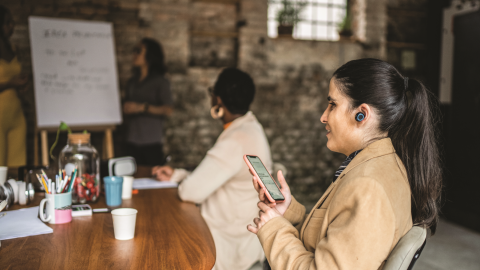Microsoft DisAbility Scholarship Winner Has a Passion for Technology and Biomedical Engineering
By almost any measure, Tara Blair was an exceptional high school student. She was in the top five percent of her class, co-founder of her school’s Science Olympiad Team, member of multiple Honor Societies, goalie on the varsity lacrosse team and co-captain of a nationally competitive ice hockey team.
This would have been an impressive high school career for any student. Blair achieved all of this with ocular albinism, a visual impairment that affects her depth perception, peripheral vision, and overall vision.
Today, Blair added another achievement, receiving the first Microsoft DisAbility Scholarship for college-bound students with a passion for technology who have a disability.
Launched earlier this year, the Microsoft DisAbility Scholarship is a grassroots effort created by the company’s internal Cross Disability Employee Resource Group (ERG) and funded entirely by employee donations. Each year, a panel of Microsoft volunteers, many with disabilities themselves, selects high school seniors with visual, hearing, cognitive, mobility or speech disabilities to receive individual scholarships for study at four-year or two-year universities, colleges or technical colleges.
The scholarship program is designed to increase the enrollment of persons living with a disability in higher education and decrease unemployment bias for disabled persons. In Washington state, for example, the percentage of adults with a disability holding a bachelor’s degree or higher is less than half that of those without a disability, 12.5 percent compared to 31.2 percent, according to the Census Bureau’s American Community Survey, according to the Census Bureau’s American Community Survey.
To win the $5,000 scholarship Blair was selected from among nearly 100 applicants.
“We were absolutely blown away by the quality of the submissions,” said Jenny Lay-Flurrie, a member of the selection committee and chair of the Cross Disability ERG. “These are incredibly impressive students with amazing potential.”
Photo of Tara Blair
Blair’s passion for technology, which was clear in her leadership of the Science Olympiad and her interest in biomedical design, was a key reason for her selection. She is already studying biomedical engineering — engineering is one of five majors covered by the scholarship — at Johns Hopkins University, where she started this fall. In fact, she exceeded many of the scholarship’s requirements, including maintaining a 3.93 high school GPA that sits well above the scholarship’s required 3.0.
As important as Blair’s GPA is her commitment to work on technology that will support those living with disabilities in their jobs and daily lives. This type of commitment is a focus of the DisAbility Scholarship program. As someone with a vision impairment, she knows she brings a critical perspective to technology design.
She learned that during her four years in high school, when she adapted technology to help with her sight impairment. As her required reading intensified it became more difficult to get it all done. Then she began bringing her laptop to school and uploading her assigned reading. She was able to magnify text and reduce her screen’s brightness from its normal setting, which was too bright for her, usually without her friends or teachers noticing. When she went to a fast-food joint, she used her tablet to call up menus online, instead of asking her friends to read her the choices.
Blair’s ability to adapt technology to fit her needs reflects the approach at the heart of accessibility work at Microsoft. Microsoft creates multiple ways for people, including those with disabilities, to interact with computing devices and content.
With the DisAbility Scholarship, Microsoft hopes to inspire the next generation of engineers, scientists, researchers and businesspeople who will develop new technology that adapts to a person’s individual needs, preferences, and immediate surroundings. Blair hopes to work on prosthetics design.
“It is still uncertain where biomedical engineering will take us in the future, but whether it is genetic sequencing, cellular scanning devices, or more affordable 3D printed prosthetics, I hope to be active in leading new technological advancements,” Blair wrote in her application for a DisAbility Scholarship.
This is the program’s first year and Microsoft has been able to fund only two scholarships. In the coming years, the selection committee hopes to raise enough money, through the Microsoft annual Employee Giving Campaign and from other sources, to fund more scholarships.
“It was heartbreaking to leave some of these students out,” said Lay-Flurrie. “We want to help as many of them as we can get into the schools they want because we know they can make valuable contributions with that education.”
To learn more about the scholarship program, which is run by The Seattle Foundation, and how you can support the program visit the Microsoft DisAbility Scholarship website.








